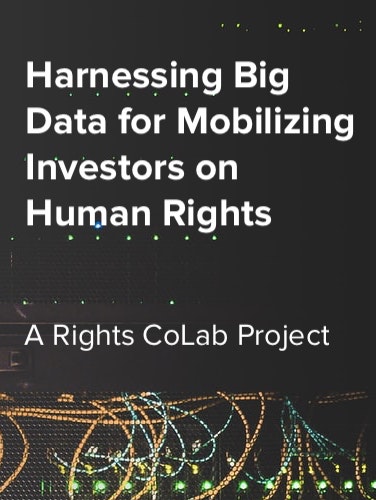Rights CoLab is collaborating with SASB to develop and define a strengthened set of disclosure standards that investors can use to persuade companies to improve labor rights for both direct employees and workers in their supply chains. The project has two components: a data science project and an Expert Group. This coalition of labor experts, data scientists, and SASB partners is focused on improving social disclosure standards that drive real gains in human rights.
The data science project, carried out with the Data for Good (DfG) program of the Data Science Institute of Columbia University, uses natural language processing and machine learning to identify new relationships between labor-related human rights risks and financial materiality.
Rights CoLab has recruited internationally recognized labor rights experts to the Expert Group to advise the project. The Expert Group has two main functions: 1) to advise the DfG researchers as subject matter experts; and 2) to advise SASB on how to revise their standards to benefit workers while reducing reputational and legal risks for companies.
This article outlines the opportunity to improve SASB standards and how this project will address the need. For information on how these standards can be a significant force for corporate accountability, see Rights CoLab’s four-part series “Moving the Market to Support Human Rights.”
Data Science Project with SASB
To understand the data science component of this project, it is important to know both how the first SASB compendium was developed and where its weaknesses lie, particularly regarding human rights.
The SASB standards were first compiled between 2013 and 2016. This timeframe affected the outcome in several ways:
- SASB bases its judgment of financial materiality partly on investor interest and partly on evidence of financial impact. Investor interest in Environmental, Social, and Corporate Governance (ESG) topics has grown exponentially since then, as has evidence of the financial impact of ESG topics.
- The volume and quality of data that can be applied to both lines of inquiry have grown exponentially.
- Methods of data analysis then were rudimentary compared to today.
- These observations are especially pertinent to social versus environmental standards.
- SASB is currently working to globalize its standards, applying them to emerging markets where new topics may be financially material.
As a result, SASB standards require updating to reflect changing evidence of financial materiality, particularly in the “social” realm. The most significant problems include illogical gaps in the SASB Materiality Map and weak human rights metrics.
- Illogical Gaps in the SASB Materiality Map
Example 1
The following standard exists in the Supply Chain Management general issue category (GIC) for iron and steel producers: “Discussion of the process for managing iron ore and/or coking coal sourcing risks arising from environmental and social issues.” This standard may have evolved from a series of reports that U.S. steel producers were importing pig iron from Brazil produced with forced labor. But it does not appear on the Materiality Map for many other industries that may import materials produced with forced labor, such as construction materials, fuel cells and industrial batteries, electrical and electronic equipment, and industrial machinery and goods.
Looking at the 2018 U.S. Department of Labor’s list of goods produced by child labor or forced labor, steel isn’t mentioned. Iron is only mentioned in connection with North Korea, while forced labor is extensively cited for bricks, cobalt, copper, fluorspar, gold, granite, gravel, gypsum, jade, mica, sand, silver, stones including limestone and pumice, tantalum, tin, tungsten, and zinc. Forced labor may be present in the supply chains of many industries for which there are no SASB supply chain disclosure standards.
Example 2
In SASB’s Labor Practices topic, minimum wage and wage violations disclosures apply to multiline and specialty retailers, food retailers, restaurants, and hotels and lodging. There is no comparable standard, however, for casinos, drug retailers, or healthcare delivery. Wage theft is a common violation among casino companies; retail and drug stores have higher rates of minimum wage violations and overtime violations than restaurants, hotels, and grocery stores; while some of the highest frequencies of overtime violations occur with home health care workers.
Example 3
Within the food and beverage sector, there are supply chain standards for every industry except tobacco, despite the fact that the U.S. Department of Labor has cited forced or child labor in tobacco supply chains in sixteen countries. Aware of this gap, SASB is currently studying whether supply chain standards should be extended to cover the tobacco industry.
- Weak Human Rights Metrics
Unlike financial accounting metrics — such as revenue and net income — SASB metrics are not, strictly speaking, required to be financially material. Topics such as “Labor Conditions in the Supply Chain” are deemed financially material for a given industry, but SASB’s Conceptual Framework requires that a metric meet different criteria. The metric must fairly represent corporate performance on the topic and be comparable, verifiable, and useful to investors and issuers alike.
For the Apparel, Accessories, and Footwear industry standard, for example, only two quantitative metrics apply to supply chains. (Apparel companies are not obliged to report on Human Capital Management topics for direct employees.)
a) “Percentage of Tier 1 supplier facilities and supplier facilities beyond Tier 1 that have been audited to a labor code of conduct, [and] percentage of total audits conducted by a third-party auditor”
b) “Priority non-conformance rate and associated corrective action rate for suppliers’ labor code of conduct audits”
Likewise, the standard for agricultural products relies on third party certification and similar metrics.
Labor advocates have long railed against ineffective social audits and the certification schemes that depend on them. Audits do not adequately capture corporate performance on treatment of workers in their supply chains, and are therefore of limited use to investors and issuers, thus causing this metric to fail SASB’s own criteria for inclusion. By contrast, academics have demonstrated that other supply chain metrics are financially material, such as the degree of visibility of the supply chain.
Metrics created with more precision, and with financial materiality as their basis, will improve the SASB compendium.
Collaboration with Columbia University’s Data Science Institute
Supported by a grant from the Moving the Market initiative of Freedom Fund, Humanity United, and UBS Optimus Foundation, Rights CoLab is collaborating with the Columbia University Data Science Institute’s Data for Good Scholars (DfG) program. Under the supervision of a faculty advisor, this program pairs undergraduate and graduate student volunteers on research projects with the potential to improve societal outcomes on a variety of issues. This collaboration aims to improve SASB’s social standards on forced labor in both direct workforces and supply chains.
We have designed two approaches to address each of the major problems outlined above.
- Fill in the Gaps of the SASB Materiality Map: “The Extension Project”
In developing its first compendium, SASB relied heavily upon risk disclosures in 10-K forms to determine evidence of financial materiality. This was straightforward, as the SEC requires every issuer to disclose its financially material risks factors in the “Risk Factors” section of the 10-K. These disclosures were augmented with earnings call transcripts and academic studies as well as investor, issuer, and subject matter expert input. But these Risk Factor sections have evolved significantly since the formulation of SASB’s first published standard. For example, Coca Cola has included the diversity of its workforce as a risk factor only since 2016.
To fill in the gaps of the SASB Materiality Map, we will begin with industries for which topics have already been determined to be material, such as the Labor Practices standard previously mentioned. SASB has kindly provided data that matches SASB risk factors to the language of the 10-K form. Using the classifier it has created, the DfG team will search for similar disclosures in industries with no comparable standard. For example, if wage violations are mentioned in the 10-Ks of casinos at a similar frequency as in the hotel and restaurant industries, then the casino industry should have a Labor Practices disclosure standard.
To augment the analysis of 10-Ks, we will analyze 10-Qs, quarterly earnings calls, and proxy filings. We will also measure the frequency of language over time to document emerging materiality. In this way, we hope to provide evidence that SASB can use to improve its Materiality Map.
- Improve the Metrics: “The Addition Project”
As we have seen in the case of SASB’s supply chain metrics, determining that a topic is financially material to an industry is no guarantee of an adequate set of standards. Data science can also be applied to improve metrics.
The Rights CoLab–DfG collaboration uses supervised learning to connect terms associated with risky business practices — such as “recruitment fees,” “migrants,” and “children” — to terms that reflect reputational and legal risks — such as “forced labor,” “impoundment,” “lawsuit,” “slavery,” “debt bondage,” “incident rate,” or “protest.” We will focus on the “practice” terms with the strongest associations to the “risk” terms and rank them by industry. We can then conduct econometric studies to reveal whether industries that have strong associations with migrants in their supply chains, or unethical recruitment practices, are more likely to be accused of forced labor, and whether these enhanced reputational risks have a bearing on corporate performance. This will constitute another body of evidence, thus contributing to improved standards, and ultimately to improved human rights conditions for workers.
Click here for a detailed description of our methodology.
Photo by fabio on Unsplash


